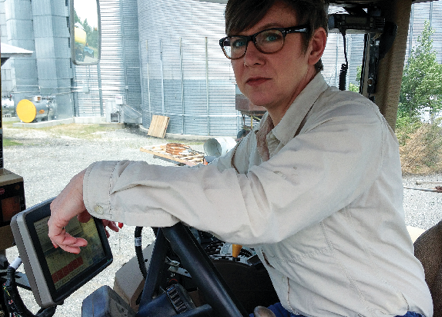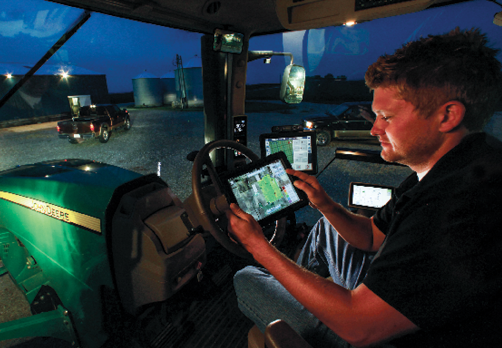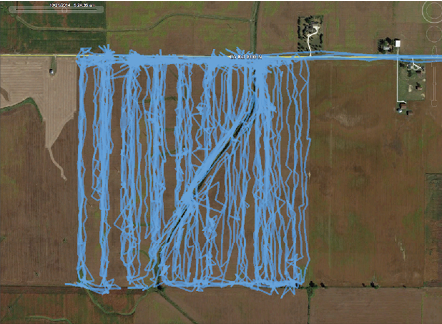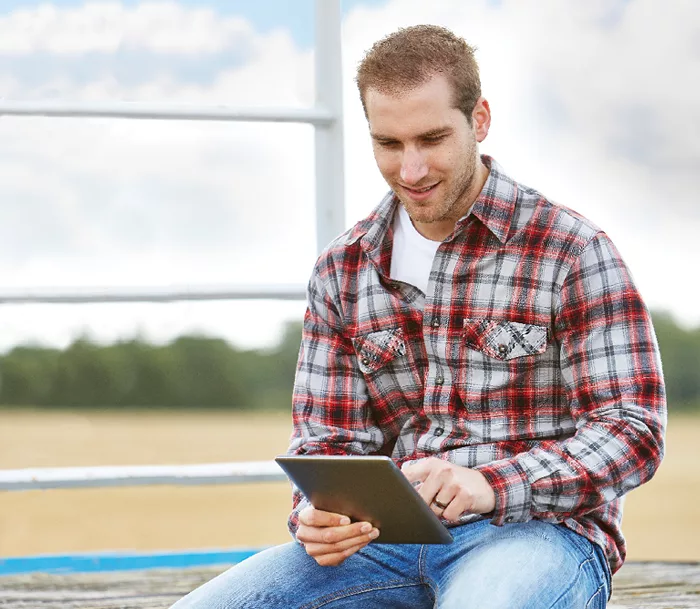For many farmers, the field of ag-specific mobile apps can feel a bit like the Wild West.
The general-use app market seems to be saturated and difficult to navigate, and the market for farming apps is no different. A broad search of “agriculture” in Apple’s App Store alone turns up 720 results.
Luckily, the market for farming apps has been evolving; separating the wheat from the chaff is a process that has been happening naturally. The most useful apps are apparently being selected for survival based on customer feedback and reviews.
Still, the time a user must spend learning to use each individual app, and the amount of data they must input before they get useful output, has many farmers asking: is it worth it?
To bring some clarity, No-Till Farmer surveyed readers about what mobile apps they use in their operations, and what value they provided. We also asked about the frustrations apps created, and which apps farmers had on their wish lists to improve efficiency and productivity in their operations.
Ag App Prevalence
According to the No-Till Farmer poll, there are plenty of growers who’ve jumped on the farming app bandwagon, but others are still mulling the idea or flatly refusing to do so. But that may come with the cost of missed opportunities in farming precision, accuracy and efficiency.
Some 45% of respondents say they use several different ag apps on a regular basis, and 28% report using them in only a limited capacity (one or two different apps). Some 10% of no-tillers say they don’t currently use ag apps, but are interested in learning, while 17% don’t make use of them at all.
Many farmers were using the same or similar apps. For instance, Ag PhD was mentioned by 24% of respondents, making it the most popular in the survey. So it’s clear there’s a trend toward farmers adding highly specialized apps to their operation and creating significant value with their use.
Integration into Fertility Programs
For Bill Rohloff, the ag app payoff came in the form helping him catch a minor issue before it became a problem. Rohloff, who no-tills corn, soybeans and wheat on about 1,200 acres near Fort Atkinson, Wis., admits he only uses a few apps, but a recent experience with an app designed to work with a fertilizer blockage monitor inspired him to be more proactive with integrating apps in 2015.

TIME SAVING APPS. Lisa Holscher, a soil health program manager with the Indiana Conservation Croppping Systems Initiative, works with farmers throughout the state on improving their farm’s soil health. In her work with farmers, she’s seen many replacing cumbersome handbooks with their app counterparts to save time when hunting for information.
Recently, Rohloff planned to apply zinc as pop-up fertilizer for corn. He was ready to hit the field, but rain pushed him back several days.
“Zinc is kind of hard to keep agitated,” says Rohloff. “What happens, if it sits for a few days, is that it starts to crystallize. Then you’ve got to clean the filter on the pump. Sometimes I’ve had it happen and probably never realized it.”
When Rohloff did get into the field, his newly installed CDS-John Blue liquid blockage monitor system and the companion app, quickly indicated that 2 rows were suffering from a blockage.
“Some of the zinc had crystallized in the manifold of the planter,” says Rohloff. “On my iPad, I could tell that the flow rate was down and I was continually getting two plugged rows. The holes are so small and hard to get to. The only thing I could do was give it a few taps with a hammer to sort of break it free. But it worked, and after that things started flowing freely.”
Many companies are releasing companion apps for their products to increase convenience and functionality, and they’re often free. In Rohloff’s case, it was the liquid blockage monitor system itself that detected the plugged rows, but the app’s built in alarm, that sounds when flow drops beneath a certain threshold, and the precise flow value displayed, is what helped him catch the problem quickly.
Additionally, he was able to gauge the effectiveness of his impromptu repair by consulting the exact numerical value of flow displayed on his iPad rather than just eyeballing the monitor.
“You normally wouldn’t know the exact amount going through, but with the app you can see the values to the individual rows,” says Rohloff. “You can see a problem right away, instead of having to look back or guess. There is so much technology today and you have to justify everything you bring in, but something like this is pretty easy to justify.”
Apps used for fertilizer application was a popular category in the survey, with 26% of respondents making use of at least one.
Lisa Holscher, a soil health program manager with the Indiana Conservation Cropping Systems Initiative, works with farmers throughout the state on improving their farm’s soil health. Being in the position to see which apps farmers are using, she says TeeJet SpraySelect seems to be saving farmers a lot of time.
“Anything I can get in my hand that will give me useful information immediately is priceless for time management…” — Ricky Kratz
“Most folks I know have the TeeJet handbook and they page through it to find the appropriate nozzle for the application,” says Holscher. “But with the app, it’s right in your pocket and only takes a minute to use. So the value is in the time savings.”
Holscher says that since using the app herself, she’s seen frequent updates and content added, but TeeJet’s easy-to-use interface is what appeals to her most. The highly specific app takes the speed, spacing, target rate and drop size category to provide a list of the best spray nozzles for spraying herbicides, broadcasting or fertilizer application.
“Making sure you’ve got the right type of nozzles for the situation is incredibly important when you’re burning down cover crops like annual ryegrass, or even when you’re dealing with weeds that are tougher to kill,” says Holscher.
Apps are also helping some farmers find the right rates with fertilizer application. Ricky Kratz, who no-tills and strip-tills about 4,800 acres near Slinger, Wis., uses Ag PhD’s nutrient removal app to obtain fertilizer-rate suggestions to meet target yields.
“It’s helpful to go back with the app to make sure my figures are right,” says Kratz. “You can punch in a yield goal and it’ll tell you how many pounds of nitrogen (N), phosphorus (P), potassium (K) and micronutrients you’ll need to hit that goal.
“Anything I can get in my hand that will give me useful information immediately is priceless for time management. It’s better than digging through a whole bunch of paperwork, doing all those calculations or writing it down and losing it in my truck.”

EYES AND EARS. Chris Hudson, who no-tills about 3,000 acres of corn and soybeans near Crawfordsville, Ind., says his farm management app’s ability to sync across multiple mobile devices helps him coordinate daily activities on the farm.
Kratz says he sometimes finds the app’s suggestions are overgenerous in terms of N, but by keeping track of his application rates he can monitor yields in certain plots and try to reproduce good results when he has them.
Rolling Out a Digital Map
Apps designed for scouting and mapping are also popular for no-tillers, with 30% of respondents using at least one app for this purpose. Many farmers use them to map out field boundaries, find irrigation pivots, scout fields and carry out a host of other functions.
Kratz has used mapping apps to gain perspective on his own farm, but also to find potentially valuable information about other acreage.
One of the apps Kratz uses is called SoilWeb, an app that has GPS-based, real-time access to USDA-NRCS soil survey data. It takes the user’s location and provides graphical summaries and detailed information about the soil types beneath their feet.
This can be very useful on a grower’s own farm and individual fields, but Kratz takes it a step further by using it to assess land that he is considering renting so he can estimate what sort of yields he may get.
“When I have that information, it helps me decide how I should bid it,” he says. “I’d normally go and walk next to the field and try to get close enough to see what the soil is like, but this way I can compare it to my soils so I don’t have to come into the deal blind.”
Roger Wenning, who no-tills 650 acres of corn, soybeans and wheat near Greensburg, Ind., is also finding ways to use map data gleaned from his mobile devices.
Wenning has found that using Google Earth and Studio Noframe’s GPS Fields Area Measure apps in tandem is revolutionizing his approach to tiling his and other farmers’ fields.
“When I use GPS Area and Google Earth for my tiling business, I can see all the features of the field,” says Wenning. “We overlay the information we get from each app, and it’s practically the same as having an airplane picture.
“If a guy says he wants to tile a certain area, we can use the information to decide how much tile we’ll have to use, and make a better estimate on supply costs.”
Wenning says that in the past he’d have to drive the field and take measurements to build an estimate. This process would take hours, especially if the field was 30-40 miles away.
Wenning says the convenience and time savings with these two apps is significant. Additionally, Google Earth’s history option allows him to page through archived aerial images of a given location. Some locations have more imagery available than others, but he’s often able to get a look at how a field has changed over time, and even occasionally spot previous tile work.

Wenning also uses these apps to plan and lay out test plots on his farm.
“It’s really easy and quick to take regular measurements of plots,” says Wenning. “If you say, ‘OK, I need 4 acres over here for a test plot,’ you can just go into the app, draw it out and then you’ve got it right there in front of you.”
Managing Acres
Farm management apps are often more complex and immersive than ag apps designed to serve a single purpose.
Because there is a large selection of these apps to choose from, no-tillers may want to start by asking what sort of data they’re looking for. Kratz has seen tremendous value in functions that give him easy access to his costs per bushel, and frequently updated local commodity prices.
“In January, I’ll go through the Growers Edge app and compute all my costs of production per bushel,” says Kratz. “Then I can set a certain margin I’m hoping to get. It sends me an email each day that lists what local co-ops are paying for grain so I can go back later and look up what my costs were and compare them.
“Some days, the market will be up $0.10 and down $0.05 the next day, but now I can decide quickly if there is a good price to sell at.”
Growers Edge is a free app that has a suite of other features, but Kratz says that he’s seen so much return on this one feature that he wouldn’t mind if he had to pay for the app.
Chris Hudson, who no-tills about 3,000 acres of corn and soybeans near Crawfordsville, Ind., says farm management apps — such as personal his favorite, Precision Planting’s FieldView — are useful for monitoring and recording planter performance, creating yield maps and scouting fields.
But he adds that apps like this are most powerful in their ability to sync across multiple mobile devices. With this capability, he can observe and coordinate efforts from anywhere on the farm across multiple seasons.
“We use FieldView’s ability to sync across multiple tablets to help with various management tasks throughout the growing season,” says Hudson. “We can build a history of scouting data and management variations. For example, if the planter operator drops a pin to note ‘wet at planting,’ it helps to identify potential lingering wet spots in the field for sidedressing or spraying but also provides analysis value at harvest to help understand why there’s a poor corn stand.”
The App Wish List
The app market in general has been experiencing a population explosion for the past few years, and as mobile devices continue to become more prevalent, there is little reason to expect a slow down — even in the agricultural sector.

THINKING OUTSIDE THE BOX. Chris Hudson couldn’t find an app that would track his grain cart’s path across the field, so he used an app designed for hikers instead. The app tracked his cart’s path via GPS and he overlaid the results on a Google Earth map. This map shows his cart’s 61.6-mile path across a 152.33-acre cornfield. The diagonal line near the center is an open ditch, and grain was being offloaded into semis on the road at the top of the picture. He hopes to use the data to optimize the cart’s natural path and reduce compaction.
Experimentation and feedback from farmers will help guide developers’ priorities.
Survey participants told No-Till Farmer that weed, pest and disease identification apps were their most sought-after wish-list item.
Several of these types of apps already exist, but are more akin to field guides that serve as a convenient reference rather than an analysis tool. It’s hard to say when the technology that enables farmers to simply snap a photo of a weed and have it immediately identified will arrive, but it’s reasonable to assume that the supply will endeavor to meet the demand.
But some farmers have taken matters into their own hands.
Hudson says he first concerns himself with what he’d like to accomplish, before looking at what apps are available on the market. This occasionally leads him to repurposing apps developed entirely for another function.
“Last fall, I wanted to track every movement that the grain cart made to see if there were any natural patterns. I was trying to identify any potential hotspots for compaction,” Hudson says. “There wasn’t an app just for that purpose, so what I did was download a hiking app that drops breadcrumbs or markers as often as you’d like, so if you’re hiking in the woods, you’re able to get back out.”
Hudson was able to put a device with this app in the grain cart and set it to routinely note the path it was taking throughout the course of harvest. He says that it has worked well and that he plans to use the data he gathered to eventually manage field traffic to reduce compaction issues.
“It was pretty interesting to follow the paths last year. This year we’ll hopefully get a bit more data that’s actionable,” says Hudson. “Using the app, I’ll be able to understand what the natural movements of the implement are and we can reduce any unnatural or unnecessary movements to create a sort of controlled traffic, or directed, route to relieve compaction.”
In some instances, farmers become developers themselves in order to address issues on the farm with emerging technology. Shawn Gengerke, CEO and founder of Leading Edge Industries, is a fourth generation farmer in northeastern South Dakota. During his more than 30 years of farming, Gengerke has looked to innovative solutions to simplify tough jobs. One such area of improvement he saw was building a grain loading system resistant to dust and darkness that offers real-time positioning data.
“Loading a grain trailer is a filthy, dirty job and it’s hard to be consistent every time you load it,” says Gengerke. “There was no good way to load it without having to stand on your trailer and monitor it.”
Gengerke was able to develop the necessary hardware to monitor grain loading remotely, which he calls the Load Judge. However, to pull data from the hardware, he also developed a Load Judge app that can be synced with multiple in-range mobile devices.
“It allows us to see the proximity of the grain to the inch with a smart device from any location as long as we are in range,” says Gengerke. “We could be in the truck, in the scale house or running the auger and conveyor buttons. The payoff is consistency in our loads and being able to do it with just one person loading.”
However, the Load Judge may be a bellwether of future farm equipment. Operating the hardware requires a mobile device and the app to run it. If equipment development on an independent, entrepreneurial scale were to follow this trend, tools like Gengerke’s may be exclusive to farmers who regularly make use of mobile devices and apps. Gengerke isn’t concerned about exclusion though. He says that because farmers need phones anyway and it’s becoming more difficult to find a phone on the market that isn’t ‘smart,’ the transition will be natural.
“It’s the future, and we recognize that a lot of companies like Case IH and Deere are using iPads as monitors already,” says Gengerke. “They’re more reliable, faster, cheaper and they’re mobile. They bring value to the marketplace for farmers and it’s really all about efficiency. In these economic times we need to do everything we can to be efficient.







